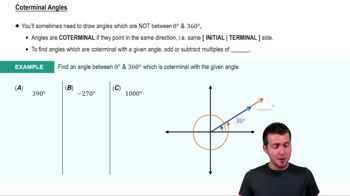Table of contents
- 0. Review of College Algebra4h 43m
- 1. Measuring Angles39m
- 2. Trigonometric Functions on Right Triangles2h 5m
- 3. Unit Circle1h 19m
- 4. Graphing Trigonometric Functions1h 19m
- 5. Inverse Trigonometric Functions and Basic Trigonometric Equations1h 41m
- 6. Trigonometric Identities and More Equations2h 34m
- 7. Non-Right Triangles1h 38m
- 8. Vectors2h 25m
- 9. Polar Equations2h 5m
- 10. Parametric Equations1h 6m
- 11. Graphing Complex Numbers1h 7m
1. Measuring Angles
Angles in Standard Position
Problem 68b
Textbook Question
Textbook QuestionConvert each angle measure to degrees, minutes, and seconds. If applicable, round to the nearest second. See Example 4(b). 174.255°
 Verified Solution
Verified SolutionThis video solution was recommended by our tutors as helpful for the problem above
Video duration:
3mPlay a video:
Was this helpful?
Key Concepts
Here are the essential concepts you must grasp in order to answer the question correctly.
Angle Conversion
Angle conversion involves changing an angle from one unit of measurement to another, such as from decimal degrees to degrees, minutes, and seconds (DMS). In DMS, one degree is divided into 60 minutes, and each minute is further divided into 60 seconds. This conversion is essential for precise measurements in various applications, including navigation and astronomy.
Recommended video:

Coterminal Angles
Degrees, Minutes, and Seconds (DMS)
Degrees, minutes, and seconds is a way to express angles where degrees are the whole number part, minutes are the fractional part of a degree multiplied by 60, and seconds are the fractional part of a minute multiplied by 60. For example, 174.255° can be converted to DMS by separating the whole number from the decimal and calculating the corresponding minutes and seconds, providing a more detailed representation of the angle.
Recommended video:

Converting between Degrees & Radians
Rounding
Rounding is the process of adjusting a number to a specified degree of accuracy. In the context of angle conversion, rounding to the nearest second means determining the closest whole second value when converting from decimal degrees to DMS. This is important for ensuring that the final angle measurement is both accurate and practical for use in real-world applications.
Recommended video:

How to Use a Calculator for Trig Functions

 5:50m
5:50mWatch next
Master Drawing Angles in Standard Position with a bite sized video explanation from Patrick Ford
Start learningRelated Videos
Related Practice













